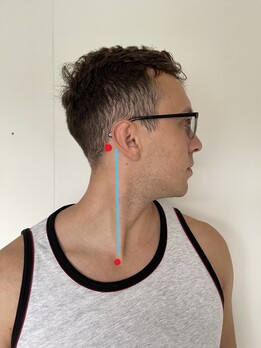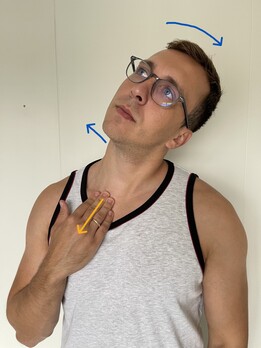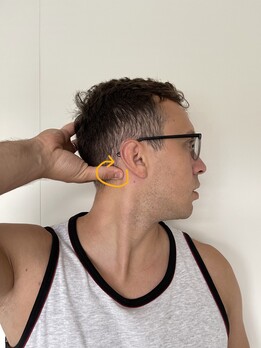Best Sternocleidomastoid Stretches for Neck Flexibility
In this article, I will show you the best way to perform a sternocleidomastoid stretch.
The Sternocleidomastoid (SCM) is a muscle in the neck that is often too tight and contributes to forward head posture.
The sternocleidomastoid muscle connects the skull to the sternum (breastbone) and clavicle (collarbone), which makes stretching the SCM a bit more challenging and tricky.
The function of the SCM is to rotate the head to the opposite side (contralaterally) and slightly flex it to the same side.
When both SCMs are active, they extend the neck and head.
Sternocleidomastoid Stretch: Step-by-step Guide
Locate SCM Attachments (Proximal & Distal)
Rotate your head towards one side, and you’ll easily locate the SCM (Sternocleidomastoid) muscle, which stretches from the collarbone to the base of the skull (mastoid process).
If you’d like, mark the two attachment points with a strip of tape.
When stretching, the goal is to move these two points as far apart from each other as possible.
Now, choose one of the self-stretching exercises for the sternocleidomastoid muscle.
Static Sternocleidomastoid Stretches
From a standing position, tilt your head to the left side and gently rotate your head slightly towards the opposite side.
Hold this position for 30 seconds.
This exercise stretches the right sternocleidomastoid muscle.
This stretch can be helpful for relieving tension in the right sternocleidomastoid muscle and improving neck flexibility.
*Remember to perform the stretch gently and without any force, and always maintain a relaxed breath during the exercise.
And try this SCM stretch:
From a standing position, use one hand to anchor the lower attachment of the SCM muscle on the collarbone.
Then, tilt your head to the left side and gently rotate your head slightly towards the opposite side, holding this position for 30 seconds.
Goal: stretching the right sternocleidomastoid muscle.
These exercises are the best sternocleidomastoid stretches that can improve the flexibility of SCM and the neck area.
These are the most commonly recommended exercises in physical therapy.
Tips When Stretching Sternocleidomastoid Muscle
Before stretching:
- Start with a gentle massage: Before stretching, use your thumb to lightly massage the upper attachment of the SCM at the base of the skull. Make circular motions with minimal pressure to help relax the muscle.
During stretching:
- Breathe deeply: When you’re stretching the SCM muscle, remember to take deep breaths. Breathing is crucial for this muscle because it’s active during breathing.
After stretching:
- Pay attention to any pain: If you experience pain while stretching the SCM muscle, it’s essential to consult with your doctor. Pain during stretching should be addressed by a healthcare professional to rule out any underlying issues or injuries.
Why is my Sternocleidomastoid Tight?
An improper head position during everyday activities, where the head is slightly tilted forward, is one of the most common reasons for experiencing tightness in the sternocleidomastoid muscle.
This position often occurs when you’re looking at a phone or computer, or if a person has slightly impaired vision and strains when reading.
This happens because when we tilt our heads forward, we put extra strain on the neck muscles, including the sternocleidomastoid.
Over time, this can lead to muscle tightness and discomfort.
Related postures to tight sternocleidomastoid are forward head posture and rounded shoulders posture.
Sources: Kenhub scm muscle, association between rounded shoulders & forward head posture & thoracic kyphosis




